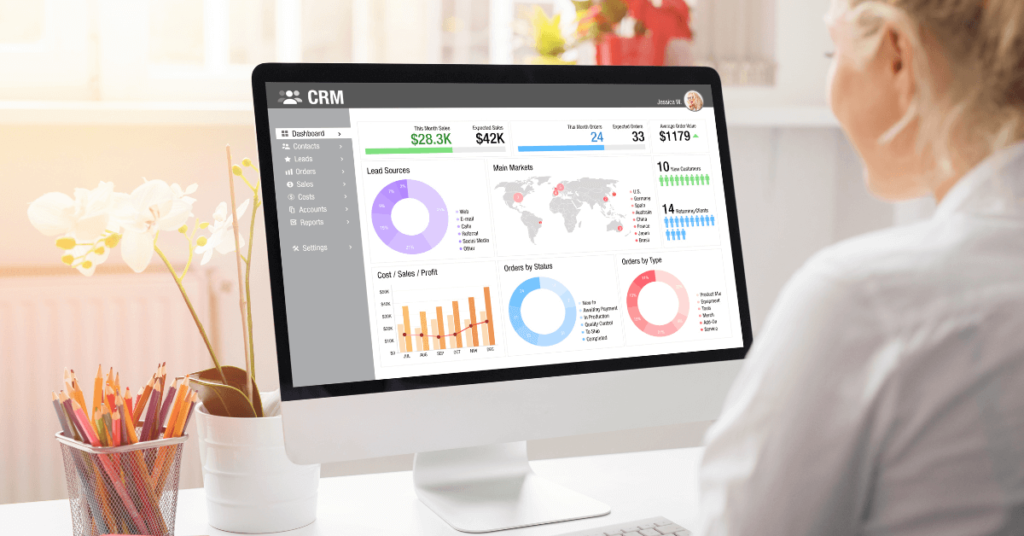Is your burgeoning B2B customer acquisition cost (CAC) draining the life out of your B2B company? That’s a problem you need to address ASAP!
Left unchecked, the cost of B2B customer acquisition can limit your company’s success in a major way. If you can’t find a way to balance your per-customer spending with the lifetime value of those same customers, it will erode your growth.
In this blog post, we cover techniques you can use to optimize your B2B customer acquisition strategy and win more customers for less.
Importance of Managing Customer Acquisition Costs
Customer acquisition cost is the money it takes to acquire new customers.
It includes the salaries of your marketing and sales teams, plus the amount you spend on content creation, advertising strategies, email marketing, and social media promotions, for example.
To maximize profits, reducing customer acquisition costs should be among your top priorities. Most B2B companies focus on amassing more budget for marketing and sales while not putting as much effort into reducing their CAC—which also directly improves their bottom line.
Tracking customer acquisition costs also helps you measure the ROI of your existing marketing strategies. It identifies gaps in your campaigns that must be patched to maximize your income potential.
Lastly, the customer acquisition cost is critical in calculating your customer’s lifetime value. This measures the total value of a B2B customer to your business throughout your relationship.

How to Calculate Customer Acquisition Costs
The typical B2B customer acquisition cost can be calculated by dividing the total cost of your marketing and sales operations by the number of customers converted.
CAC = (Marketing + Sales Costs) ÷ New Customers
Suppose you spent $7,000 on sales and marketing and generated a total of 24 new customers. Plug these numbers into the formula above to get your customer acquisition cost.
$7,000 ÷ 24
CAC = $291.66
Businesses sometimes split their customer acquisition cost for organic and inorganic campaigns.
Organic customer acquisition cost considers the total cost of campaigns that organically generate customers. This includes SEO, content marketing, and organic social.
Inorganic customer acquisition cost, however, measures the spend on paid or outbound campaigns—think PPC advertising and cold calling.
Refer to industry reports for the average customer acquisition B2B cost in your niche.
For example, SEO company First Page Sage released the average organic and inorganic customer acquisition costs of 17 B2B industries.
Here are some of their findings:
- Financial services: $644 average organic CAC, $1,202 average inorganic CAC
- B2B SaaS: $205 average organic CAC, $341 average inorganic CAC
- Business consulting: $410 average organic CAC, $901 average inorganic CAC
- Manufacturing & distribution: $662 average organic CAC, $905 average inorganic CAC
- Medical devices: $501 average organic CAC, $755 average inorganic CAC
How to Reduce CACs to Improve ROI
If you perform worse than your B2B customer acquisition cost benchmark, below are seven strategies you can use to achieve better results.
1. Switch to Intent-Driven Lead Generation
Intent-driven lead generation leverages buyer data to hone the efficiency of digital marketing campaigns.
Statistics show that 55% of sales leaders use intent data to improve B2B sales. These companies ensure marketing and sales resources are allocated for in-market buyers—not just any prospect who’s far from a purchase decision.
Intent data can be obtained from multiple sources, namely:
- Third-party cookies
- Media brokers
- Marketing analytics software
- First-party sources (purchase history, conversations, etc.)
These intent data streams provide you with a clearer picture of your ideal B2B prospect. Moreover, they help marketers and salespeople tailor experiences to your prospect’s immediate goals.
2. Use Prospect Prioritization
Another use of intent data is to optimize B2B account prioritization.
Prospect prioritization irons out marketing and sales inefficiencies through ICP (Ideal Customer Profile) and persona matching. It identifies “lookalike” leads who resemble customers that already bought from you.
Some of the benefits of prospect prioritization are:
- Marketing resource optimization: Maximize the budget, time, and workforce invested in prospecting by taking ill-fitting leads out of the picture.
- Improve sales performance: Build a database of hot, in-market buyers that enables salespeople to do their best work.
- Keep passive buyers interested: Understand which prospects aren’t ready for a purchase but keep them interested with lead nurturing initiatives.
To implement prospect prioritization, start with conversion-qualified leads. These are prospects who completed any type of conversion, like downloading your white paper or signing up for your webinar.
You should also monitor “trigger” events that activate a lead’s buying cycle and move them up your prioritization ladder.
Some examples of these events are management changes, news of problems with their current suppliers, and launches of marketing initiatives that align with your company’s services.
3. Invest in Sales Enablement
Sales enablement is the process of equipping salespeople with information and resources to supercharge their efficiency. It’s the coming together of everyone from marketing, finance, HR, sales, management, and every other relevant department to help salespeople be their best.
Effective sales enablement starts with the cultivation of an open marketplace of ideas within your company.
A shared knowledge base, for example, provides salespeople with all the data they need to understand customers. They need information on raised concerns from the customer support team, features being implemented from the development team, most downloaded assets from the marketing team, and so on.
Sales enablement also requires these prerequisites:
- Sales content performance tracking
- Sales enablement training
- Selling guidelines based on top performers
Gel your sales enablement strategy together with a dedicated sales enablement team.
According to the Global Sales Enablement Survey by HubSpot, 65% of businesses that exceeded revenue goals had a designated person or team who took on the challenges associated with sales enablement. This allowed everyone else, including marketers and salespeople, to focus on their main responsibilities.

4. Pay Attention to Technology and Firmographic Insights
A lot of businesses ignore technographics and firmographics when crafting their ICP.
Technographic data analyzes the technology stack of prospects. It answers questions like:
- What business apps and solutions do prospects use?
- How do they utilize these solutions?
- Do they require any hardware for these solutions?
Firmographics, on the other hand, analyze a prospective organization’s buying process, budget, and decision-making team.
To segment B2B prospects, businesses use a variety of firmographic identifiers, like:
- Business type
- Industry
- Revenue
- Primary location
Looking at technographics and firmographics allows marketers and salespeople to learn exactly what each prospect needs, when they need it, and who to pitch to. It adds an extra layer of accuracy to their lead targeting strategy—elevating efficiency and cutting down customer acquisition costs.
5. Incorporate Predictive Intent Analysis into Your Content Marketing
Predictive intent analysis takes raw intent data and maps the buyer’s journey trajectory through AI, machine learning, and data modeling. In other words, it uses past customer data to make predictions about the prospect’s future interactions.
Incorporate predictive intent data into your content marketing strategy to personalize experiences based on the prospect’s unique challenges and research patterns. This also eliminates the possibility of creating marketing content that will only go unused.
To use predictive intent targeting, you need to pick a data partner that supplies high-quality intent data from multiple verified sources.
It’s one thing to set up intent data streams and obtain the means of measurement—it’s another to have a system that crunches the numbers and produces actionable, predictive insights.
6. Implement Content Scoring
Content scoring lets you reduce customer acquisition costs by tweaking your content creation activities. It can maximize profits by ensuring resources go into developing revenue-generating content—not digital waste that will only gather virtual dust.
Due to the twists and turns of the buyer’s journey, each business needs to develop its own content scoring strategy. But it always starts with identifying content performance metrics and knowing where each content type fits in the sales funnel.
For example, if a piece of content fits in the “awareness” stage, its performance score should depend heavily on these metrics:
- Website traffic
- Social media shares
- Click-throughs
- Social media likes
Some examples of content in the awareness stage are blog articles, guest posts, and social media posts.
Content at the “action” stage, however, must be evaluated based primarily on conversion rate. That’s because content pieces in this stage of the funnel aren’t expected to pull in traffic—they’re meant to turn existing traffic into paying customers.
7. Use Email Marketing
Data reveals that email marketing efforts generate an average of $36 for every $1 invested.
To get the high ROI that email is capable of, integrate intent data into the campaign planning step.
Use a well-defined lead qualification process to identify your hottest target accounts. Factor in their firmographics, technographics, and previous interactions with your business to create a high-priority email list segment.
Here are a few other tips to help maximize the efficiency of your email marketing:
- Enrich your database using your email marketing platform’s reporting feature. Analyze metrics like scheduled discovery calls, downloads, and previous purchases.
- Run surveys through email to better grasp your ICP’s content preferences. Surveys can also be used to learn why some prospects went cold—allowing you to devise a remarketing campaign and adopt strategies that keep leads warm.
- Build your relationship outside of email. Use display ads, content sponsorships, and influencer marketing to reach your ideal prospects before they sign up for your email list.
Spending Money to Make Money?
The irony of customer acquisition cost optimization is that you need to put in more money before spending less on each customer. You need to acquire, analyze, and organize data, after all.
Implementing prospect prioritization, sales enablement, content scoring, and so on requires a considerable budget for guaranteed results.
DemandScience offers a workaround by giving you access to over 70 million verified contacts. Not only that, but we can also hand-deliver the perfect leads through predictive intent analysis, content syndication, competitor displacement campaigns, and more.
Reach out to us to learn more.












